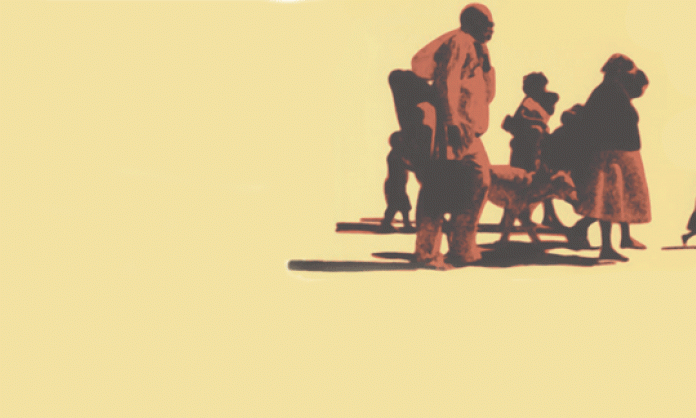At least 800 Aboriginal people walked off about 25 sheep and cattle stations across the Pilbara in north-west Australia and from workplaces in Port Hedland and Marble Bar on May Day, 1946. The date was chosen because of its significance as the international day of the working class.
This remarkable strike became the longest in Australia’s history, lasting more than three years. It established significantly improved conditions for Aboriginal pastoral workers.
Significantly, it educated a layer of non-Aboriginal workers about the racist injustices that blighted Aboriginal lives. The Australian Workers Union’s application in 1936 to include Aboriginal workers in the pastoral award had been denied, so many were paid less than half award wages, if anything other than their keep. Emphasising this status as virtual slaves, they were denied the freedom to move from place to place, or to control their own money.
The idea of a strike was first discussed at a six-week long gathering in 1942 of about 200 senior Aboriginal law men representing 23 language groups from much of north-west Australia. But the strike was postponed until the end of the war.
The lawmen Dooley Bin Bin and Clancy McKenna became the most prominent leaders. For two years they travelled around the stations, sitting down with workers, convincing them to plan for the day. Every station was given a calendar with the days listed until May Day 1946. Designated leaders had the job of marking off each day at sunset.
Don McLeod, a white member of the Communist Party of Australia (CPA), had won their trust while working in the area for several years. One of the demands of the strike was that McLeod, rather than government “protection” officers, be their official representative.
The strikers suffered harassment and cruelty at the hands of the cops. Many served time in jail; some were seized by police at revolver point and put into chains. Clancy was arrested in late April but not charged until 7 May, when he was sentenced to three months’ jail for inciting “natives” to strike. When Dooley was arrested the first time, he was chained to the grille of a cell for six days until charged.
McLeod was jailed three times for being within five chains (100 metres) of a congregation of natives, three times for inciting natives to leave their lawful employment. In Port Hedland in 1946 the Aboriginal strikers marched on the jail and McLeod was freed.
At the Five Mile Camp near Marble Bar, two cops shot the people’s dogs, even when they were chained up between their owners’ legs. This threat to people’s lives provoked the usually good-natured strikers, who, led by local strike leader Jacob Oberdoo, disarmed the cops.
Trade unionists around the country, often informed by CPA material, responded. Nineteen unions in WA, seven national unions and four trades and labour councils supported the strike and sent money. The Committee for the Defence of Native Rights, which included the CPA and Christians, organised a public meeting of 300 in the Perth Town Hall.
Wages and conditions were eventually won at Mt Edgar and Limestone stations, setting a standard. Strikers would return to work only for the same or better pay and conditions. But pastoralists would offer higher wages to attract workers for the shearing, only to renege when it was finished, provoking a new walk-off.
Then in August 1949, the West Australian branch of the Seamen’s Union banned the shipment of wool from the Pilbara. After three days, McLeod was told by a government representative that the strikers’ demands would be met if the ban was lifted. In spite of government denials of any agreement, the strike soon ended with a substantial victory.
Many never returned to work, instead living on properties they set up as cooperatives under their own control. Some survive to this day. The Pilbara strike implanted the idea of land rights, which was to inspire the Gurindji strike in 1966, and established that Aboriginal workers could inspire solidarity from thousands of non-Aboriginal workers for their struggle for justice.
Mumaring, a forgotten woman rebel of the Pilbara
There is a hidden women’s history of the historic Pilbara strike of 1946. The most common narrative is of male Aboriginal leaders organising their mob to survive in camps by hunting and shallow mining. You sometimes get a glimpse of women collecting pearl shell for money.
But it’s clear that women played a key role as strikers and as family members in setting up and maintaining camps where people could survive together. Communist Party writer Katherine Prichard wrote an account of one of these women.
She is Mumaring of the Nyangumarda people, known as Daisy Bindi, born about 1904 on a cattle station near Jigalong Aboriginal Reserve in north-west Western Australia.
As a child, she learned household skills and appears to have received no formal education. But she did become an accomplished horsewoman.
Living and working on a number of pastoral stations, apart from the day to day humiliations meted out by her bosses, she both saw and suffered indignities inflicted by the police, who regularly raided Aboriginal camps.
She became a fluent and lively speaker. And in 1945 Daisy organised a meeting to convey the call sent out for a strike. She was so prominent organising for the strike that police threatened to remove her from the district.
She demanded and received wages from her white employer at Roy Hill station and saved up to hire a truck with which to collect local workers when the strike began on May Day, 1946.
In spite of intimidation by both police and the government to prevent the strike, 500 men, women and children walked off the stations south of Nullagine and made their way to Port Hedland.
At Nullagine, Daisy talked her way through a police confrontation where she claimed that she had never heard of McLeod, and, with as many as 96 others, made her way via Marble Bar to Canning Camp on the Shaw River.
Daisy remained an activist after the strike in the Pindan Pty Ltd cooperative settlement, Port Hedland, set up by the strikers. Three years before her death in 1962, while in Perth to have an artificial leg fitted after an accident, she attended meetings of CPA women and their supporters.
Mumaring’s role in the incredible Pilbara strike is a reminder that wherever there is a struggle for freedom, there you will find rebel women.











